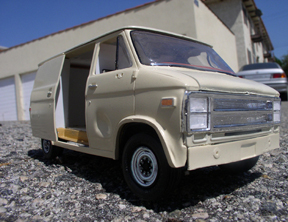CLASS: C
Mobile gallery since 2001
CLASS: C mobile gallery project has been intervening in the public and private sphere since December 2001. Housing an office, gallery, and storage space within his family's former delivery van, Ochoa has merged both his art practice and street vending experience to create a roving “white cube.” As owner of the vehicle and creator of the mobile art space, CLASS: C, Ochoa's roll varies in degrees as an artist, curator, and collaborator. Thus challenging exhibition techniques as well as the rolls artists and curators assume.
Current Contact Info:
Ruben Ochoa
classcgallery@yahoo.com
www.artshowhere.com
Other:
CLASS: C is contextually specific. It is born of Southern Cali 's automobile obsession, where most San Diegen's and Angeleno's spend a good deal of time in their cars. We see lines of “Cars-for-Cars-Sake” on the highway, new SUVs, Lexus', etc. “Rebellious Sub-Culture Cars,” hot rods, low riders, and rice rockets. “Rolling billboard vehicles” that shamelessly peddle cell phones and strip clubs, all the while contributing to smog and road congestion, so why not a rolling art gallery? Why not supplement California 's car culture with art culture?
Housed in the shell of and '85 Chevy, the vehicle once served my family's business as a tortilla delivery van. Now with fully customized interiors, the vehicle takes on another function. Titled CLASS: C, this mobile gallery/event is intended to expose featured artists' works to a wide cross section of viewers at multiple venues across Southern California it also serves to depict the multi-faceted working dynamics of the gallery system.
The concept of a mobile gallery is not new people have been renting trucks and commercial vehicles for quite some time. However rental trucks and U-hauls that simply hang artwork in their interior work on a very different level than CLASS: C. None are fully crafted and customized to emulate “the white cube” of the gallery or museum space like CLASS: C has been. While many outside systems have worked specifically or primarily as anti-gallery structures, CLASS: C seeks to blur the lines between the high and low as well as the private and public spheres.
CLASS: C functions on many levels. It strips away the “magic behind the scenes,” and the highfalutin' status often associated with an “ Art Gallery ” — humbling the gallery setting by placing the artwork in a working-class everyday beater (the van). Furthermore, as an alternative space, it not only deals with the tension between gallery, artists and audience, but also raises questions regarding size-specificity and site-specificity of work. Further complicating matters is my multiple roles as owner of the vehicle, creator of the “art space,” and chief curator and collaborator. I plan to remain flexible enough to juggle my many roles, even though I anticipate times when one role conflicts with another. The CLASS: C project is intended to challenge traditional exhibition techniques, forcing artists to reevaluate what constitutes “an exhibition.” Its limited gallery space and mobile nature present new challenges and possibilities to existing arts institutions as well as artists.
Art that forces social interaction, reaction, even disruption — these are the qualities that fuel ideas such as CLASS: C. The project explores the barriers that exist between varying social and economic classes who might or might not ever have the opportunity to view art exhibitions in their neighborhoods. Thus allowing the rules of the road to be limitless, CLASS: C has the ability to exhibit throughout the vicinity of Los Angeles , San Diego , the Inland Empire or as far as the freeways go.
View All Other:
vehicle

Class C Image 1